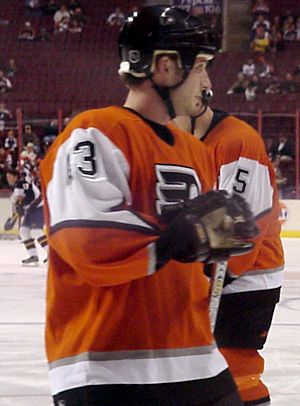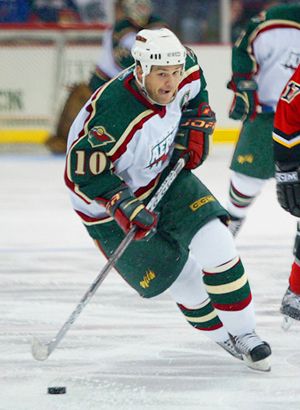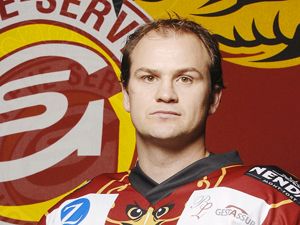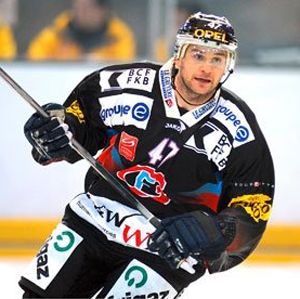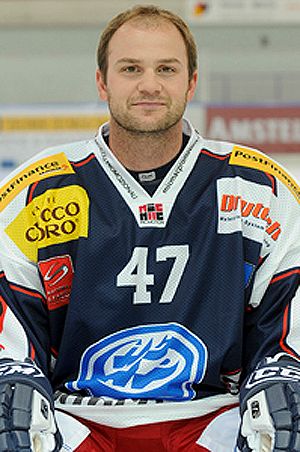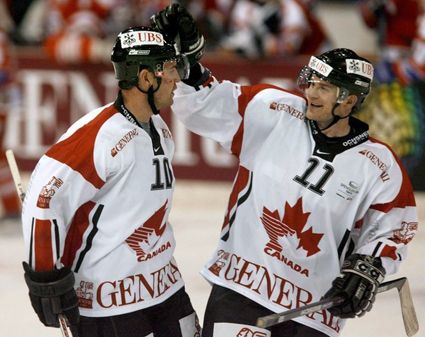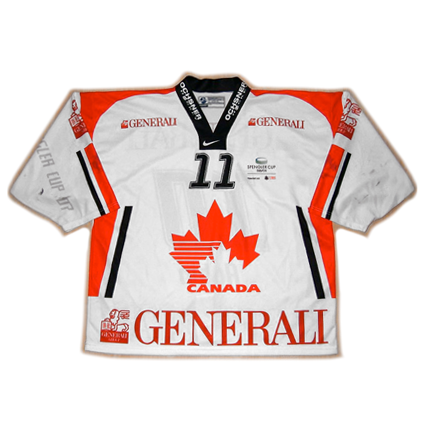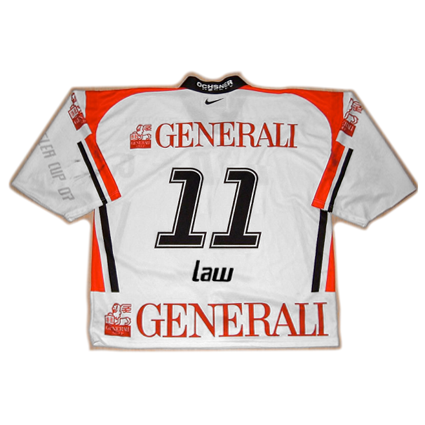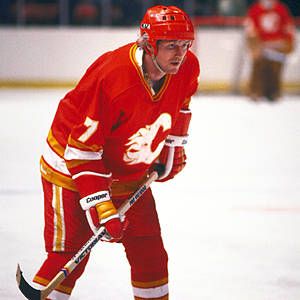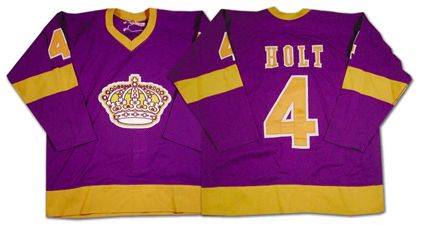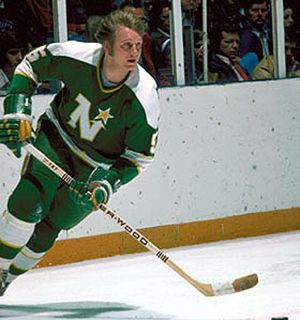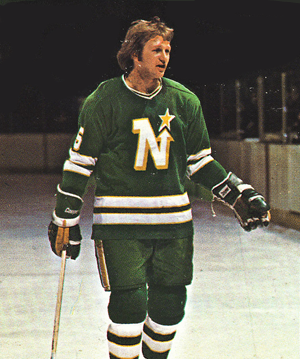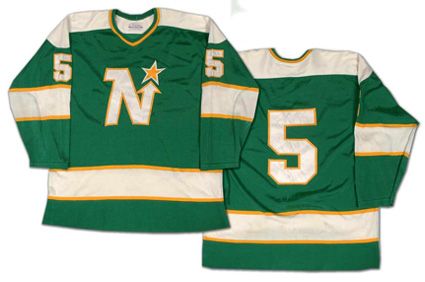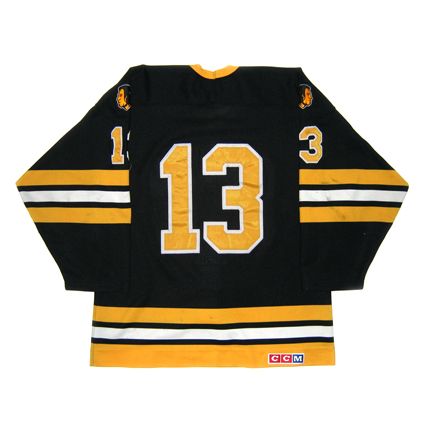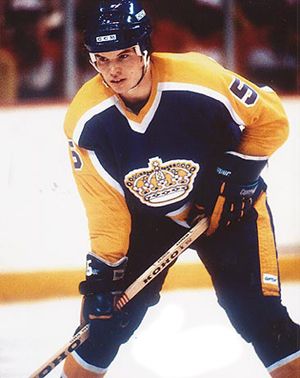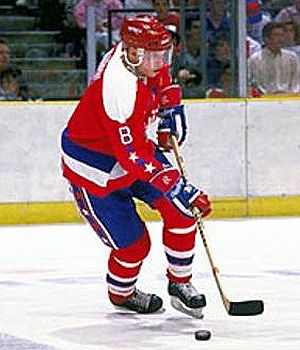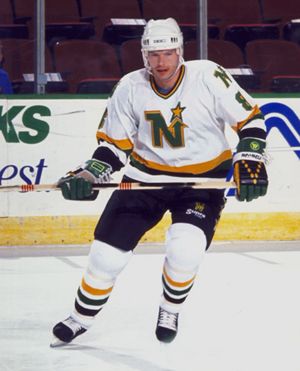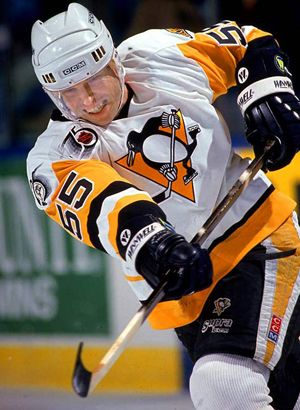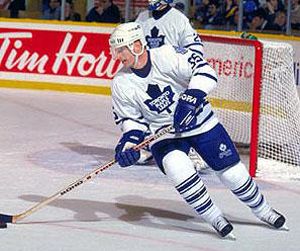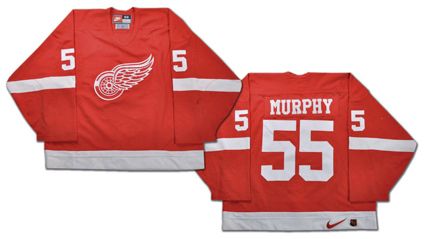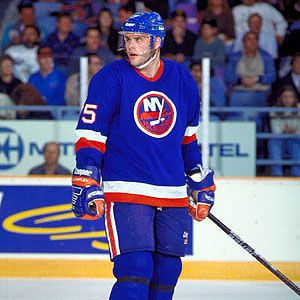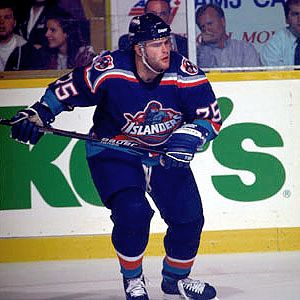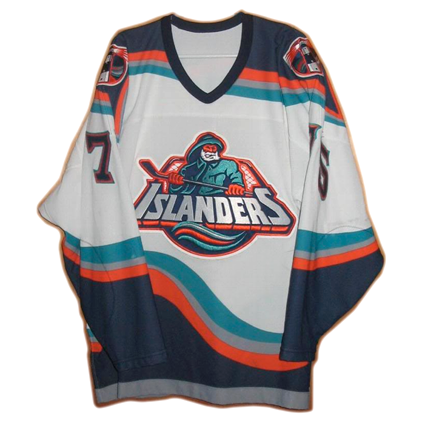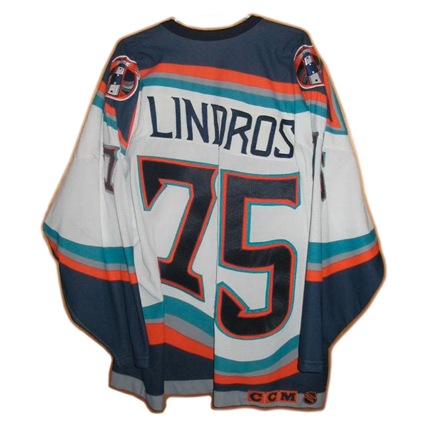Saturday, March 12, 2011
2007 Team Canada Kirby Law Jersey
Not every player can enjoy a career like that of Steve Yzerman, who played 22 seasons with just one club, yet there are many players who carve out long careers in hockey yet are virtually unknown to many. One such player is Kirby Law, who was born on this date in 1977.
Law, a winger, began his junior hockey career at the age of 16 with the Saskatoon Blades of the Western Hockey League in 1993-94. His second season saw him play 46 games with Saskatoon before joining the Lethbridge Hurricanes for the final 24 games of the season. He returned to Lethbridge for two more years and in 1996-97 averaged more than a point per game for the first time with 39 goals and 52 assists for 91 points, as well as 200 penalty minutes, in 91 games. Law also scored 18 points in 19 playoff contests as Lethbridge advanced all the way to the Memorial Cup Final.
He was traded to the Brandon Wheat Kings prior to the start of the 1997-98 season where he played an injury shortened 49 game season, but still put up impressive averages, scoring 34 goals and 44 assists for 78 points and 153 penalty minutes in the rough Western League.
Undrafted by the NHL, Law found employment with the Orlando Solar Bears of the International Hockey League for the 1998-99 season, where he played 67 games before joining the Adirondack Red Wings of the American Hockey League for 11 regular season games and the first round of their playoffs.
That summer Law was signed as a free agent by the Atlanta Thrashers and played the majority of the year with the short-lived Louisville Panthers of the AHL. His rights were traded by Atlanta to the Philadelphia Flyers who assigned Law to their top minor league affiliate, the Philadelphia Phantoms of the AHL for the remainder of the season.
He finished the next season fourth in scoring for the Phantoms with 61 points in 78 games and continued to play his usual rough and rugged style so common in WHL graduates with 150 penalty minutes. He also had the thrill of making his NHL debut with the Philadelphia Flyers when he was called up for a single game.
The pattern was now set, as Law played 71 games for the Phantoms without a call-up in 2001-02, 74 games in the AHL and two games for the Flyers in 2002-03 and 74 games for the Phantoms, scoring 73 points in 74 games, and six games for the Flyers, which included an assist, Law's first and only NHL point, in 2003-04 season.
Law was then signed by the Minnesota Wild organization and assigned to the Houston Aeros of the AHL. With the NHL season cancelled that season, there was no possibility of a call-up.
While Law finished the season with 49 points in 80 games in 2004-05, his offensive game exploded the next season as he scored 43 goals, his first season of 40 goals or more at any level. Additionally, he was credited with 67 assists for 110 points to earn the Aeros team captain captured the Sollenberger Trophy as the leading scorer in the AHL.
Despite leading the AHL in scoring, it was not enough to earn even a single game with the offensively challenged Wild (24th out of 30 in NHL scoring). Law then began the European phase of his career when he joined Geneve Servette Eagles of the Swiss National League A for 2006-07. He returned to Servette for a second season and averaged more than a point per game his two seasons with the club, 91 in 80 games over the two seasons.
He moved even farther east in 2008-09 with ten games in the Kontinental Hockey League for Nizhnekamsk Neftekhimik before returning to Switzerland and joining HC Fribourg-Gotteron for the reminder of the season.
2009-10 was yet another new club for Law, HC Ambri Piotta, also of the Swiss NLA.
Despite only registering a single NHL point during his career, Law has played 1,165 games, scoring 409 goals and 546 assists for 955 points and 1,852 penalty minutes.
While playing in Switzerland in 2007-08, Law was named as a member of Team Canada for the annual Spengler Cup tournament, held annually between Christmas and New Year Eve since 1923, which featured not only Team Canada, mainly comprised of Canadians playing professionally in Europe each season, but club teams from the Czech Republic, Germany, Russia and the hosts HC Davos. During their four games in the round robin portion of the competition, Canada won 3 in regulation and another in overtime to finish first and qualify for the finals against HC Salavaat Yulaev Ufa of the KHL, whom Canada defeated 2-1, with Law scoring the first goal for Canada 7 minutes into the second period to help Canada earn their first Spengler Cup since 2003.
Today's featured jersey is a 2007 Team Canada Kirby Law jersey as worn during the Spengler Cup tournament. Canada's Spengler Cup jerseys regularly feature the "speeding leaf within a leaf" logo, which has otherwise not been used on Canadian jerseys since 1995 when the black and red Hockey Canada logo with the silhouette of a player was first introduced.
Today's video segment has Law earning some of his many penalty minutes while with the Phantoms in the AHL.
Friday, March 11, 2011
1978-79 Los Angeles Kings Randy Holt Jersey
One of the toughest players in the NHL during his career, Randy Holt began his junior hockey career with the Niagara Falls Flyers of the Ontario Hockey Association in 1970-71. The defenseman scored five goals and 12 points in 35 games with 178 penalty minutes. After another season with the Flyers, Holt moved to the Sudbury Wolves. With Sudbury, Holt attracted the attention of NHL scouts with a complete season, scoring seven goals and a noteworthy 42 assists in 55 games for 49 points while racking up 294 penalty minutes, second most in the OHA. That combination of offensive contribution combined with his undeniable toughness led to him being taken early in the 4th round, 41st overall, by the Chicago Black Hawks in the 1973 NHL Amateur Draft.
Holt would spend the next four seasons playing primarily with the Black Hawks minor league affiliate in the Central Hockey League, the Dallas Black Hawks. In 1973-74 he was second in the league in penalty minutes, with 222 in 66 games. During the playoffs, Holt and the Black Hawks captured the CHL championship.
For the 1974-75 season Holt again spent the majority of his time in Dallas. In 65 games he scored 8 goals and 32 assists for 40 points. More noteworthy however, was his 411 penalty minutes, a full 167 more than the league runner-up (and over 200 more than his older brother Gary of the Salt Lake Golden Eagles)!
He also made his NHL debut that season, playing in 12 games with Chicago which included his first NHL point with a single assist. He also registered his first NHL fight on his way to the first 13 penalty minutes of his career.
In 1975-76 Holt again saw action in 12 games for the Black Hawks but once again spent the majority of the season in Dallas. He again contributed offensively with 46 assists and 52 points, but reigned in his aggression, reducing his penalty minutes to just 161. He split time once more between the NHL and CHL in 1976-77, his third consecutive year playing exactly 12 games with Chicago.
He began the 1977-78 season with Chicago, but after six games, Holt was traded to the Cleveland Barons in November. In 48 games with the Barons, Holt saw his penalty minutes climb to 229. Combined with the 20 he already accumulated in Chicago, Holt's 249 (in 54 games) was good enough for 4th most in the league.
In an unusual business deal, the Barons franchise was merged with the Minnesota North Stars and Holt was claimed by the Vancouver Canucks in a dispersal draft as part of the process. he was a member of the Canucks for 22 games, which included scoring his second NHL goal, prior to being traded to the Los Angeles Kings on December 31, 1978.
After joining the Kings, he played in 36 games, racking up 202 penalty minutes, which included a league record 67 minutes on this date in 1979 during the first period of a game against the Philadelphia Flyers in Philadelphia.
Holt received his first minor penalty at 10:25. At 14:48 he was charged with two majors and a 10 minute misconduct, raising his total to 22. At the conclusion of the period a the players came together and a fight broke out. Finally Holt and noted Flyer tough guy Paul Holmgren fought for a time. After another fight involving other players, Holt and Holmgren again began to brawl, this time throwing some real bombs. After the brawling was over, Holt received a fighting major, a misconduct and three game misconduct penalties for 45 minutes, which added on to his earlier 22 minutes, gave him a record 67 minutes in penalties, which still stands today. He also holds the distinction of being the only player in NHL history penalized more minutes than the length of an actual game! Holt was eventually suspended three games for his part in the melee, which he was ruled to have instigated in an attempt to get at the Flyers Ken Linseman who Holt wanted to retaliate against for an elbow to the mouth earlier in the period.
In all, ten players were tossed out of the game, including Frank Bathe of Philadelphia, who set a Flyers club record with 55 penalty minutes of his own.
"I've been in all-outers five times in my life," Holt recalled, explaining that an "all-outer" is a bench clearing brawl. "Of those five, four have been against Philadelphia. And all four was because of me, because I'd stand up to them. The way Philadelphia plays is a gang war against one guy.
"I got in a couple of fights with a defenseman by the name of Frank Bathe. Then Blake Dunlop was playing for them, and he turned around and said something to me which you would never say under normal circumstances. Only because he's in Philly and playing for them.
"So I drove him in the head. I went to the bench, and then Bobby Clarke skated to their bench and said: 'We're gonna get him at the end of the period.' Soon as the period ended, they all leaped over the boards for me. So I already had the two fights, then I caught (Paul) Holmgren and a couple other guys. I don't know how they sorted it (the penalty minutes) all out.
"It's not a thing I'm proud of. But I am proud to say I stood up to them. Anything they threw at me I threw back."
"I got in a couple of fights with a defenseman by the name of Frank Bathe. Then Blake Dunlop was playing for them, and he turned around and said something to me which you would never say under normal circumstances. Only because he's in Philly and playing for them.
"So I drove him in the head. I went to the bench, and then Bobby Clarke skated to their bench and said: 'We're gonna get him at the end of the period.' Soon as the period ended, they all leaped over the boards for me. So I already had the two fights, then I caught (Paul) Holmgren and a couple other guys. I don't know how they sorted it (the penalty minutes) all out.
"It's not a thing I'm proud of. But I am proud to say I stood up to them. Anything they threw at me I threw back."
Holt's combined 282 minutes were second in the league for 1978-79, just 16 behind the legendary Dave "Tiger" Williams, with whom Holt fought on a number of occasions throughout his career.
Following the 1979-80 season during which Holt played 42 games for the Kings, he was traded to the Calgary Flames. He played in 48 games for Calgary plus an additional 13 playoff games.
1981-82 saw Holt again on the move, for after eight games with Calgary, a trade was completed which saw him join the Washington Capitals.
He found much more playing time with the Capitals, 53 games for the remainder of 1981-82, which included a career "high" of two goals, and 70 games in 1982-83, by far the highest total of his NHL career. While his 259 minutes in penalties were just enough to scrape him into the top 10, Holt's 275 minutes in 1982-83 made him the NHL's most penalized player for the season for the first time in his now nine year career, besting Williams by ten minutes.
Holt signed as a free agent with the Flyers for the 1983-84 season, but only saw the ice in 26 games before retiring from hockey. His final NHL totals are 395 games played over ten seasons, 4 goals and 37 assists for 41 points and 1,438 penalty minutes, the equivalent of 24 full games in the penalty box.
Today's featured jersey is a 1978-79 Los Angeles Kings Randy Holt jersey as worn during the game during which he was assessed an NHL record 67 penalty minutes. The Kings original 1967 jerseys were very much the same as the 1978-79 jerseys, only with simple one color numbers and no names on the back. Two seasons later white outlines were added to the crest and numbers, with names permanently arriving in 1977. These jerseys would continue to be used through the 1979-80 season.
Today's video segment begins with the record setting brawl at the end of the period which earned Holt the single game penalty minute record. The video is a a bit unusual, as it's from a video tape, which is at times both fast forwarded and rewound!
Our second video is another coming together between Holt and Linseman, which causes both benches to empty after Holt attempts to ram Linseman's face into the ice.
Labels:
Holt,
Los Angeles Kings
Thursday, March 10, 2011
1977-78 Cleveland Barons Dennis O'Brien Jersey
Dennis O'Brien played his junior hockey with the St. Catharines Black Hawks in the Ontario Hockey League in 1968-69. The defenseman was then selected by the Minnesota North Stars in the 1969 NHL Amateur Draft in the second round, 14th overall.
He spent the entire 1969-70 season honing his craft with the Iowa Stars of the Central Hockey League, the only season that edition of the Stars would exist. While with Iowa, he was credited with 20 points from 2 goals and 18 assists in 72 games while amassing a league leading 331 penalty minutes, 73 more than the notorious Andre "Moose" Dupont.
During the following season of 1970-71, O'Brien split time between the minor league Cleveland Barons of the American Hockey League and made his NHL debut with the North Stars of the NHL. He played exactly 27 games with each team and scored his first NHL goal on his way to a total of three for the season. When the North Stars qualified for the playoffs, O'Brien got his first taste of postseason play with nine games for the North Stars.
Now established as a genuine NHLer, O'Brien would play six full seasons on the Minnesota blueline. His stay at home, hard hitting defensive style would not earn him many points, but it would make him a steady, reliable member of the North Stars defensive corps. In five of his six seasons in Minnesota, O'Brien would play at least 70 games five times with a high of six goals and 24 points in 1976-77.
O'Brien would begin his eighth season with the North Stars in 1977-78 but after 13 games he was claimed on waivers by the Colorado Rockies on December 2, 1977. He would see action in 16 games for the Rockies before being traded to the Cleveland Barons on January 12, 1978. He would log 23 games in Cleveland prior to again being placed on waivers. Then on this date in 1978, O'Brien became the first player in NHL history to be with four different NHL teams in one season when he was claimed by the Boston Bruins.
Once with Boston his situation was again settled, as there was still enough time to play in the Bruins final 16 games of the regular season and contribute to the Bruins playoff effort, as Boston made it all the way to the 1978 Stanley Cup Finals.
After all the movement from team to team to team to team the previous season, O'Brien must have been relieved to play the entire 1978-79 season with the Bruins, save for a pair of games with the Rochester Americans in the AHL.
O'Brien briefly laced up his skates for one final season in 1979-80 with three games with the Bruins and six games with the Binghamton Dusters in the AHL before retiring.
His final stats were 592 games played, scoring 13 goals and 91 assists for 122 points and 1,017 penalty minutes, with his highest being 187 in 1975-76.
Today's featured jersey is a 1977-78 Cleveland Barons Dennis O'Brien jersey as worn during his record setting season during which he became the first player to play for four different NHL teams in a single season. To date, only one other player has equalled that amount, Dave McLlwain in 1992, who coincidentally joined his fourth team on the same date of March 10th.
The Barons only existed for two seasons, yet there are detail differences between the jerseys used both years. This particular jersey does not have the state of Ohio shaped sleeve patches, which contained the arm numbers during the Barons first season. Additionally, the sleeve numbers were relocated to the red shoulder areas for their second and final season. Also, the sans-serif font for the player names was changed to a serifed font as seen on today's featured jersey.
Bonus jersey: Today's bonus jersey is a 1970-71 Minnesota North Stars Dennis O'Brien jersey as worn during his rookie season in the NHL. The North Stars wore this particular style from the start of their second season of 1968-69 through 1971-72 and always without names on the back.
Today's video clip is a pretty intense fight between the Cleveland Barons and the Boston Bruins, two of the clubs Dennis O'Brien played for in 1977-78.
Labels:
Cleveland Barons,
O'Brien Dennis
Wednesday, March 9, 2011
2004-05 Warroad Warriors Zach Larson Jersey
The Minnesota State Boys' Hockey Tournament begins today with the quarterfinals in Class A, followed by the start of the Class AA tournament tomorrow. Class AA consists of the top 64 schools by enrollment in the state and Class A is for the remaining schools. In terms of enrollment, Class AA is roughly for schools with 1,200 students or more, with the largest of the Twin Cities suburban schools reaching enrollments of 3,000.
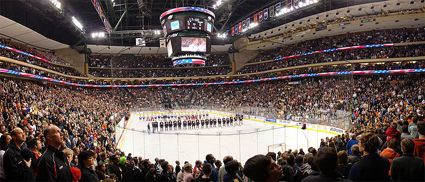
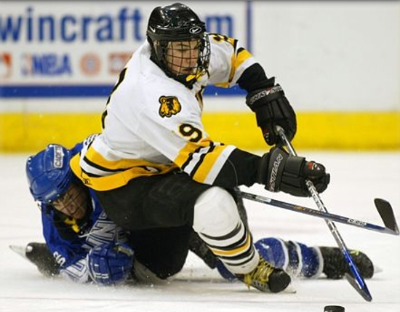
Often compared to the Indiana State Boys' Basketball Tournament or the Texas and Florida State Football Tournaments as the most important nationally for their sport, the Minnesota State Boys' Hockey Tournament is a four day festival of excitement, color and sound as the parents, relatives, fans, cheerleaders (on skates!) and bands from 16 schools all travel to the state capital of St. Paul to cheer on their teams as they compete on the ice at the home of the Minnesota Wild, the Xcel Energy Center, in front of sell out crowds of up to 19,500 fans.

The tournament began back in 1945 in St. Paul. After a stop at the home of the Minnesota North Stars, the Met Center, for eight years in the 1970's, the tournament returned to St. Paul at the new St. Paul Civic Center, known for it's clear boards, which you can see below in one of today's videos. For nearly 50 years the tournament was played as an eight team, single class tournament, which lent itself to classic David versus Goliath matchups, as the smaller schools from the northern part of the state travelled down to the big city, taking on some of the largest schools attendance-wise in the state.
Controversially, the tournament split into two classes in 1994, based on enrollment. While schools in the smaller enrollment Class A have the option to move up and play in Class AA, the tournament lost something special in the process. Still, it is the largest state sports tournament in the United States in terms of attendance and viewership, as all the championship bracket games are broadcast on local television. On March 7, 2008 19,559 fans attended the semi-finals, setting a new record for the largest crowed to ever attend a hockey game in Minnesota, exceeding even the Minnesota Wild's largest crowed.
Many NHL veterans have participated in the tournament, including Neal Broten, Phil Housley, Reed Larson, John Mayasich, Mike Antonovich, Henry Boucha, Mark Parrish and current NHLers T. J. Oshie of the St. Louis Blues and Blake Wheeler of the Atlanta Thrashers. Of the 19 Minnesota players taken in the first round of the NHL Entry Draft between 2000 and 2009, 13 of them played in the state tournament.
Many rivalries, dynasties, villains and favorites have emerged over the years, with small schools from up north such as Eveleth, Greenway of Coleraine, International Falls and Warroad always being sentimental favorites. Roseau, in particular, has been one of the only small schools (enrollment 410 in 2009, compared to 24 Twin Cities schools between 2000-3100 students, and well below the 1200 cut-off point for Class AA status) to move up to AA and succeed with championships in 1999 and 2007.
Other schools have had their runs, with Eveleth in the late 40's/early 50's, International Falls in the 1960's, Bloomington Jefferson dominating in the early 1990's, but none more so than Edina, with ten championships, the first coming in 1969, four in the 1970's, three in the 1980's, one in 1997 and another one just last year. All those titles, as well as seemingly annual tournament appearances, put the Hornets at the top of the list of "teams you love to hate", as teams from the tony Minneapolis suburb Edina are considered to be "the rich kids", even sporting green and gold jerseys in the color of money, earning the Hornets the derisive nickname the "Cake Eaters", which they annoyingly wholly embrace!
Other schools on the outs with the general public are the private schools, such as The Academy of Holy Angels (champions in 2002 and 2005) and Hill-Murray (1983, 1991, 2008), who are considered to have the advantage of being able to recruit the best players to attend their schools rather than take what comes their way in the case of the traditional public schools who draw students from their local geographic region. This "class war" is an age old argument between the public and private schools and is only magnified with the arrival of a smaller school from the north, such as when tiny Roseau makes an appearance in St. Paul, and is one of the driving forces behind the ongoing popularity of the tournament, as every great drama must have it's villain.
Since it's inception Class A has been a battle between the smaller private schools, with Benilde-St. Margaret's, St. Thomas Academy, Totino-Grace and Breck winning nine championships and the smaller schools from the northern part of the state now given a chance to compete for a state title, with classic schools like Eveleth and International Falls able to win their first titles since the early 1970's and first time winners like Hermantown, Red Wing and four time Class A champion Warroad flying the flag for the public schools who have captured eight titles since the two class system was introduced.
This year's tournament begins today at 11 AM with the quarterfinals in Class A with the traditional mix of #1 seeded St. Thomas Academy, a private school from the Twin Cities, taking on New Ulm from the south central part of the state, #2 seed and traditional Class A power Breck, another private school from the Twin Cities, against Thief River Falls from the northwest corner of the state 70 miles from the Canadian border, #3 seeded private school Rochester Lourdes facing another classic small school from the Paul Bunyan country in the north, Hibbing, and #2 seed Hermantown from up north outside of Duluth, facing Alexandria from the west central part of the state.
Class AA begins on Thursday when #1 seeded Twin Cities suburban powerhouse Eden Prairie squares off against Lakeville North from the southern suburbs. #4 ranked Eagan from the southeast suburbs takes on the Spuds from Moorhead, which is located in the northwest part of the state across the river from Fargo, North Dakota. That game is followed by another Twin Cities suburban entry White Bear Lake taking on #3 Duluth East, champions in 1995 and 1998 who were led by the prolific Dave Spehar, who once had hat tricks in each of his three tournament games in 1995, something no one has ever done before or since, making Spehar an instant tournament legend. Friday concludes with the #2 "Cake Eaters" from Edina (not them again!) taking on Blaine from the northern suburbs, champions in 2000.
The semi-finals for both classes are held Friday with the championships being played on Saturday.
It's a huge deal to make it "to state" in Minnesota. This past week thousands of fans attended the eight section finals just for right to go to the state tournament, which for the kids involved means staying in a hotel in the big city, playing in an NHL arena with your buddies that you grew up with in front of all your family and friends and having your games televised live throughout the state. Many players have gone on to win national championships in college and even in the NHL, and over and over again when asked for their greatest hockey memory, the answer frequently comes back "playing in the state tournament in high school." Not necessarily winning it, just playing in it.
Once, a hockey writer quoted former three time national champion University of Minnesota and 1980 "Miracle on Ice" USA Olympic coach Herb Brooks as saying that winning a state championship with St. Paul Johnson in 1955 was one of the best moments in his career. Brooks called the writer to inform him that he had been misquoted. He said it was the best moment.
Cardinals, Bengals, Mustangs, Greyhounds, Wildcats, Hornets, Hawks, Bluejackets, Panthers, Spuds, Cadets, Prowlers, Bears and Eagles, Eagles, Eagles.
Today's featured jersey is a 2005 Warroad Warriors Zach Larson jersey. This jersey was worn by players at Warroad High School from 2001 to half way through the 2008-09 season. Warroad won the Class A championship in 2003 and 2005 with jerseys from this set, but being a #13 jersey, there were several seasons in which no one chose the unlucky sweater number 13.
Larson defied superstition and wore this jersey during their undefeated (29-0-2) championship season of 2005, and was a teammate to current St. Louis Blues forward Oshie, who is the all-time leading scorer in Warroad history with 104 goals and 137 assists for 241 points in just 93 games. Oshie led the entire state of Minnesota in 2004-05 with 37 goals and 100 points.

Warroad Warrior T. J. Oshie
Other notable hockey players to come from Warroad include Dave Christian, a member of the Miracle on Ice 1980 gold medal winning USA Olympic team, who would go on to play 15 NHL seasons with Winnipeg, Washington, Boston, St. Louis and Chicago, Dave's father Bill Christian and uncle Roger Christian, who won gold medals in the 1960 Olympics, and Boucha, a 1972 silver Olympic medalist who would play for Detroit, Minnesota, Kansas City and Colorado of the NHL.
This is a classic looking jersey in the style and colors of the old Boston Bruins jerseys of the mid 70's to the mid 90's and is one of the few remaining schools to use a Native American nickname and imagery, while others such as Grand Rapids, Minneapolis Southwest and Burnsville all discontinued their use. The use of the Warriors name by Warroad High School is approved by the local Ojibwe band of Chippewa Indians who designed the logo used on the Warriors jerseys.
Due to the multiple years of service the jerseys often see, names on the back are seldom, if ever, worn on high school jerseys.
Let's se if we can possibly capture the event, spirit and emotion of the tournament with today's video selections.
Here's some classic footage from 1984 with St. Paul Johnson defeating Hill-Murray showing the unique clear boards from the St. Paul Civic Center and everyone wearing Cooperalls!
Check out the explosion of joy as Hill-Murray captures the state title in 2008 over Edina.
Tuesday, March 8, 2011
1996-97 Detroit Red Wings Larry Murphy Jersey
Born on this date in 1961, Larry Murphy, played in 1,615 games over 20 NHL seasons and currently ranks 8th in career games played despite having retired 10 years ago.
After being drafted fourth overall in 1980, Murphy began his career with the Los Angeles Kings in 1980-81 scoring 16 goals and set NHL records with 60 assists and 76 points for a rookie defenseman.
After posting 66 and 62 point seasons in Los Angeles, Murphy would be traded early in the 1983-84 season to the Washington Capitals where he would continue to put up strong numbers, the best of which was in 1986-87 when he set a career high with 23 goals plus 58 assists for 81 points.
Murphy was dealt to the Minnesota North Stars along with Mike Gartner in a blockbuster deal for Dino Ciccarelli and Bob Rouse in March of 1989 after six seasons with the Capitals. After finishing up the 1988-89 season with Minnesota, he would play one full season with the North Stars, scoring 68 points, and then a half a season in 1990-91 before once more being traded, this time to the Pittsburgh Penguins.
The move to Pittsburgh would allow Murphy to experience a deep run into the playoffs for the first time in his career, never having made it past the second round during his ten previous seasons. As the Penguins progressed through the 1991 playoffs, they first defeated the New Jersey Devils in seven games, the Capitals in five and Boston Bruins in six, giving Murphy the chance to skate for the Stanley Cup against his former club, the North Stars. The Penguins dispatched Minnesota in six games, earning him the first Stanley Cup of his career as he contributed 23 points in 23 games.
In his first full season in Pittsburgh, Murphy scored 77 points in 77 games, thanks in part to the fourth 20 goal season of his career. He would add another 16 points in 21 playoff games as the Penguins would capture their second consecutive Stanley Cup.
The following season Murphy had his career best offensive season with 85 points and another 20 goal season with 22. After two more seasons with the Penguins, Murphy was dealt to the Toronto Maple Leafs for the 1995-96 season. His stay was not a long one however, as he was shipped to the Detroit Red Wings at the trading deadline during his second season with Toronto.
Murphy ended up playing more playoff games with Detroit than regular season games as the Red Wings charged through the playoffs that season and defeated the Philadelphia Flyers for the 1997 Stanley Cup, the third of Murphy's career.
Motivated by the injuries suffered by Vladimir Konstantinov while still celebrating their Stanley Cup victory in 1997, the Red Wings followed up that success with another championship in 1998, giving Murphy four Stanley Cup championships, and making Murphy the only player to win four Stanley Cups in the decade of the 1990's.
He would close out his career with three additional seasons with the Red Wings, which included playing 57 games in his final season of 2000-01, one of which was the 1,600th game of his 21-year career, only the second player to reach that mark after Gordie Howe. His final total of 1,615 games was an NHL record for defensemen at the time. He would complete his career with 287 goals and 929 assists for 1,216 points, third all time for defensemen when he retired behind only Ray Bourque and Paul Coffey.
In addition to his four Stanley Cup titles, Murphy also won a Memorial Cup in Canadian junior hockey with the Peterborough Petes.
Internationally, Murphy played for Canada in the 1980 World Junior Tournament and the 1985, 1987 and 2000 World Championships, earning a silver medal in 1985.
Murphy scored a goal and two assists in the final game of the 1987 Canada Cup as Canada took the championship. He was also a member of the championship winning Team Canada squad in the 1991 Canada Cup as well.
Today's featured jersey is a 1997-98 Detroit Red Wings Larry Murphy jersey. If this particular one stands out as being different or "off", it's because of the font used for the name on the back. The Red Wings use vertically arched tall, thin letters without serifs during the regular season, but have a tradition of using short, thick letters with serifs during the preseason, such as the name on the back of today's featured jersey, a policy unique to the Red Wings. Once the season begins, those who make the team have the honor of wearing the jerseys reserved for the regular season.
Today's first video is the Red Wings emotional Stanley Cup victory in 1998. While the audio and video are not the greatest, it's still one of the most memorable moments in NHL history.
Next, Murphy teaches you how to properly kill a penalty in a session of "Lessons with Larry".
Labels:
Detroit Red Wings,
Murphy Larry
Monday, March 7, 2011
1995-96 New York Islanders Brett Lindros Jersey
Born in London, Ontario in 1975, Brett Lindros played his junior hockey for the Kingston Frontenacs beginning in the 1992-93 season. The right winger competed in 31 games that season, scoring 11 goals and 11 assists for 22 points while amassing 162 penalty minutes. During that same season he also skated for the Canadian National Team in another 11 games, during which he scored a goal and 6 assists.
In 1993-94, Lindros was once more a member of the Canadian National Team, a full season club which played a full season of games against both various national teams and club teams all over the world with the long term goal of preparing a cohesive team in preparation for the Olympics. The program lasted from 1983 until 1998, when the NHL began to shut down to allow it's players to compete in the Olympics.
In 44 games with the national team, Lindros scored 7 goals and 7 assists for 14 points. In addition the rugged forward was whistled for 118 penalty minutes. Aside from his time with the national team, Lindros also played 15 regular season and three playoff games with Kingston, scoring 4 goals and 6 assists.
At the conclusion of the season, Lindros was drafted 9th overall by the New York Islanders in the 1994 NHL Entry Draft.
Due to the lockout of 1994, the NHL did not begin it's season on time, and Lindros remained in Kingston for the first 26 games of the season. His offensive game took a step forward, as he found his goal scoring touch and lit the lamp 24 times in 26 games. Additionally, he was credited with 23 assists for a total of 47 points, an average of nearly 2 per game (1.81) in anticipation of making his NHL debut.
With the labor issues finally settled, Lindros joined the Islanders and saw action in 33 of the Islanders 48 games. He scored his first NHL goal and added three assists and a dose of grit with 100 penalty minutes.
The next season Lindros played in just 18 games, scoring once with a pair of assists before being forced to retire due to repeated concussions, including a final one in November 1995 which ended his career at the age of 20 after just 51 NHL games with 2 goals and 5 assists.
"When I was playing I was having memory loss even on the bench," he said. "I'd get back to the bench and if I'd been out there sometimes I wouldn't remember what I did."
"What was scary for me was each time it took longer to resolve. My last concussion before my 20th birthday took eight or nine weeks."
Having already suffered several concussions in juniors, he had another occurrence during his rookie season and then finally two in eight days which led multiple doctors to advise him to quit hockey due to the possibility of blindness and permanent brain damage.
"No one has wanted to talk about concussions until recently, especially in hockey," Lindros said back in 1996.
That sentiment certainly has changed 15 years later as players, teams and doctors are much more aware and more cautious of concussions than when Lindros was forced to retire in 1995. Just recently the NHL has taken steps to penalize hits to the head in an effort to reduce concussions, while the IIHF has simply taken a no tolerance policy of hits to the head, stating "there is no such thing as a clean hit to the head", giving not only a major penalty, but ejecting and suspending for one game any player who makes contact above the shoulder pads and subjecting the offending player to further suspension upon review.
Today's featured jersey is a 1995-96 New York Islanders Brett Lindros jersey. Lindros' rookie season saw him wear the classic Islanders jersey as worn during their Stanley Cup dynasty of the 1980's during that jerseys final season.
The next year was the debut of the Islanders ill-fated "Fish Sticks" jersey, so named for the resemblance of the logo to the Gorton's brand of fish sticks. The jersey was adopted by the Islanders new owners, hoping for a fresh start after a very down period in the win column. Turmoil on the ice and with the roster did little to improve the Islanders prospects and the jersey became a focal point of fan unhappiness with the franchise, which was not helped by the jersey being mocked by rival fans, those of the New York Rangers in particular.
For a more detailed story on the Islanders "Fish Sticks" jersey, please see our earlier entry as part of our "Curious, Weird and Ugly" Collection.
Today's video section begins with Lindros first NHL goal, one of only two he would score.
Up next, Lindros being drafted 9th overall by the New York Islanders and donning the classic Islanders jersey worn during his first season.
Here is an interview with Lindros on a local Long Island morning news program promoting an Islanders players charity car wash. He also discusses the Islanders new "fisherman" jersey for a moment.
Finally, notorious dirty player Claude Lemieux, sitting on the Devils bench, slugs Lindros during a scuffle and draws Lindros' ire.
Labels:
Lindros Brett,
New York Islanders
Sunday, March 6, 2011
The World Map of Jerseys Featured on Third String Goalie
Today we wanted to draw some attention to one of the features of this website that you may not have been aware of or spent any time looking at. Buried way, way at the bottom of the homepage is a map of the locations of the arenas of every team we have featured here at Third String Goalie, 183 in all.
Some teams, such as the Montreal Canadiens and Toronto Maple Leafs with their longevity, have played in more than one rink, so those teams have more than one pin on the map.
In the case of national teams, some countries have one main arena which always, or nearly always, will host the national team, and we have made every effort to identify those locations. When we were not able to determine a main rink for a country, such as Iceland, or in the case of Canada or the United States, where the national teams play games in multiple locations as a rule, we have placed a marker on the site of the nation's capital.
The locations mapped stretch from Anchorage, Alaska to Tokyo, Japan and north from Reykjavik, Iceland to Miami, Florida and from beginner mighty mite level hockey up to the NHL and Olympics. To date, we have featured 22 different countries so far, with more on the way.
To explore the map, either click on a pin to be taken to a detailed view of it's location, or click on this link to open the map in a large size in a new window. Once there, you will also see a list of team names down the left hand side of the page. Clicking on any of those will also take you to a more detailed view of that team's location.
You can also easily zoom in or out with the sliding scale to the left of the map and even turn on the photo option to see what now sits on the location of arenas long gone.
We hope you take a few minutes to take a look what we may have posted from your area or simply check out the variety of locations we have featured from across North America and the world of hockey.
Labels:
Jersey Map
Subscribe to:
Comments (Atom)

